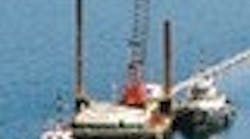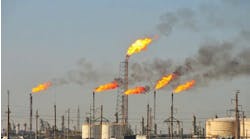By David W. Spitzer, CONTROL Contributor
Flow measurement devices can be used in many creative and novel ways. When I worked at Nepera Inc., Harriman, N.Y., an existing sump pump discharge flowmeter exhibited the seemingly undesirable characteristic of being susceptible to vibration. My interest in flowmeters prompted me to suggest that this flowmeter be evaluated, and replaced if its measurement was deemed useful. However, my astute instrument foreman noticed that flow measurement noise was reduced after sump pump replacement. With the noise as a guide, subsequently, this flowmeter was used to detect when the sump pump needed to be repaired or replaced. Needless to say, the existing flowmeter was left “as is.” Imagine that—using a flowmeter to monitor motor health!
Not only can flowmeter applications be weird, but they also can appear in many out-of-the-ordinary places, including those cement mixers, amusement parks and underneath Lake Ontario.
The Meter in the Lake
Imagine monitoring and controlling the flow from a hidden lake that’s almost 100 meters below Lake Ontario. Enwave Energy in Toronto operates the Deep Lake Water Cooling (DLWC) system, which uses water from the underground lake to provide cooling to approximately 100 buildings in downtown Toronto.
Flowmeters such as this one are used by Enwave Energy, Toronto, to help calculate energy consumption and provide real-time diagnostic information. (Photo courtesy of Enwave Energy.)
Stephen Perkins, vice president of engineering, explains, “Heat exchangers transfer cold energy from the lake water to the separate closed water loop that distributes cooling energy to our customers. The water is then fed into the city’s potable water system to avoid the potential negative impact of returning the warmed water into the lake.”
“Enrave calculates its customers’ bills based on the energy consumed,” adds Joe Incontri, sales and marketing director for flow and level measuring instrument maker Krohne. “Measurements of flow and inlet and outlet temperature are used to calculate energy consumption. The flow measurement is implemented using our magnetic flowmeters, which also are networked over telephone lines to provide real-time flow information that can help diagnose operational problems.”
Overall, Perkins is pleased with the short delivery times and the accuracy of the magnetic flowmeters. “The worst thing would be to start having an argument about the bills, and that’s why we’re so fussy about the quality of the flowmeters that we use,” adds Perkins. “The environmental benefits are quite dramatic because the DLWC consumes only one-tenth of the electricity compared to conventional chillers, and eliminates approximately 61 megawatts of demand from Ontario’s electrical system. This process removes the introduction of approximately 80,000 tons of carbon monoxide into the air annually, and eliminates the use of large quantities of ozone-depleting refrigerants. In addition, this cooling process eliminates noise, vibration and the allocation of space for refrigeration equipment.”
The Cement Mixer
You know those big, slow-moving concrete trucks you inevitably get stuck behind on a two-lane highway? There’s a lot going on inside that behemoth while you’re trying to figure out a way to pass it. It might even have a system from Universal Flow Monitors that automates the batch water additions and the water used to wash the chute after the concrete is dispensed.
Erik Rosaen, Universal’s vice president, explains that the system “uses a single vortex-shedding flowmeter for both the water addition and washout. The satellite navigation system can then forward this information to monitor cement quality by allowing dispatchers to monitor, record and check the amount of water added to the cement. Monitoring washout flow allows the truck to be redeployed immediately after the chute is cleaned.”
Hitting the Slopes
Flowmeters can also make skiing more enjoyable, while maintaining efficiency and improving safety. Anthony DiCarlo, a GE Sensing application engineer, recalls “a number of applications where the amount of snow made on the mountain is measured. The amount of snow made can be compared with the amount of nitrogen consumed to ensure that the snow-making machine is operating efficiently and economically.”
Ultrasonic flowmeters in this snowmaking machine measure the water flow to the slope, while differential pressure flowmeters measure the return water. The difference between the two measurements is the amount of snow being made by the snowmaking machines. (Photo courtesy of Gunstock Mountain Resort.)
Jack Bradley, mountain maintenance services manager at Gunstock Mountain Resort, Gilford, N.H., maintains the snowmaking machines and the system that circulates water to the various snowmakers’ connections on the mountain. “Ultrasonic flowmeters measure the water flow to the slope, while differential pressure flowmeters measure the return water. The difference between the two measurements is the amount of snow being made by the snowmaking machines.
“However, this system is particularly important during start-up or when no snow is being made. Large differences between the two measurements at these times can indicate a potential leak or open connection. The leaks not only waste water, but also can cause a safety hazard when the water freezes and turns into ice,” explains Bradley.
Roller Coaster Ride
Have you ever accelerated from 0 to 128 miles per hour in 3.5 seconds or ascended and descended over 450 feet in a few seconds? You would have if you’d ridden the tallest and fastest roller coaster in the world—Kingda Ka at Six Flags Great Adventure in Jackson, N.J.
Craig Miklencic, sales engineer at Applied Analytics got the call to supply ABB magnetic flowmeters to measure the cooling water for the hydraulic system used to accelerate the roller coaster and catapult it up its structure.
However, it’s not just the Kingda Ka ride that needs flowmeters at the amusement park. Keith Edmonds, PE, infrastructure and environmental engineer at engineering consultancy Hatch Mott McDonald, says, “This project was so large that several engineering companies were necessary to complete the design and construction within the project schedule.”
Hatch had extensive experience with Great Adventure’s independent infrastructure that supports the park, its rides and numerous entertainment features. In particular, the independent water and wastewater handling systems contain multiple production wells, a water treatment plant, storage and distribution systems, and multiple industrial filtration systems to maintain water quality for a variety of rides.
The hydraulic system pushes the Kingda Ka roller coaster up this steep structure and accelerates the cars from 0 mph to 128 mph in 3.5 seconds. (Photo courtesy of Six Flags Great Adventure.)
This industrial expertise was used in the design and construction of the cooling system for the hydraulic drive of the roller coaster that’s critical to its operation and, in particular, the design and installation of its cooling water flowmeter to ensure proper operation.
Flowmeters are workhorses that turn up in the all the “usual” places, such as chemical and petrochemical plants, steel mills, paper mills, water and wastewater plants, and food production machinery. Because they’re so ubiquitous, they tend to be overlooked. More glamorous technology gets all the ink.
However, many flowmeters have this knack of turning up in unusual applications. Whether you’re on the world’s tallest roller coaster, down in a sewer, 100 ft. below the Great Lakes, skiing down a mountain, driving a car, or just sitting at home, a flowmeter is probably closer than you might think.
| About the Author |



